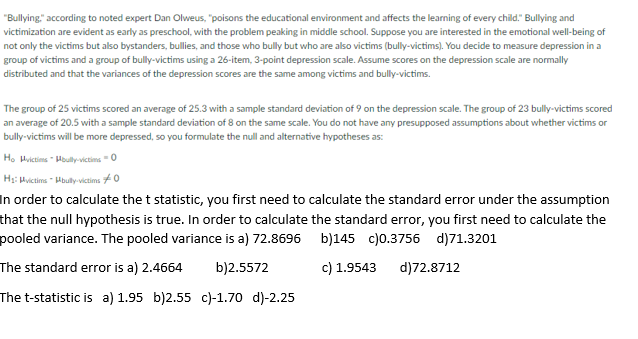"Bullying." according to noted expert Dan Olweus, "poisons the educational environment and affects the learning of every child." Bullying and victimization are evident as early as preschool, with the problem peaking in middle school. Suppose you are interested in the emotional well-being of not only the victims but also bystanders, bullies, and those who bully but who are also victims (bully-victims). You decide to measure depression in a group of victims and a group of bully-victims using a 26-item, 3-point depression scale. Assume scores on the depression scale are normally distributed and that the variances of the depression scores are the same among victims and bully-victims. The group of 25 victims scored an average of 25.3 with a sample standard deviation of 9 on the depression scale. The group of 23 bully-victims scored an average of 20.5 with a sample standard deviation of 8 on the same scale. You do not have any presupposed assumptions about whether victims or bully-victims will be more depressed, so you formulate the null and alternative hypotheses as: Họ Muictins Houly victima -0 Hạ: Mictims Hbuly victims A0 In order to calculate the t statistic, you first need to calculate the standard error under the assumption that the null hypothesis is true. In order to calculate the standard error, you first need to calculate the pooled variance. The pooled variance is a) 72.8696 b)145 c)0.3756 d)71.3201 The standard error is a) 2.4664 b)2.5572 c) 1.9543 d)72.8712 The t-statistic a) 1.95 b)2.55 c)-1.70 d)-2.25
"Bullying." according to noted expert Dan Olweus, "poisons the educational environment and affects the learning of every child." Bullying and victimization are evident as early as preschool, with the problem peaking in middle school. Suppose you are interested in the emotional well-being of not only the victims but also bystanders, bullies, and those who bully but who are also victims (bully-victims). You decide to measure depression in a group of victims and a group of bully-victims using a 26-item, 3-point depression scale. Assume scores on the depression scale are normally distributed and that the variances of the depression scores are the same among victims and bully-victims. The group of 25 victims scored an average of 25.3 with a sample standard deviation of 9 on the depression scale. The group of 23 bully-victims scored an average of 20.5 with a sample standard deviation of 8 on the same scale. You do not have any presupposed assumptions about whether victims or bully-victims will be more depressed, so you formulate the null and alternative hypotheses as: Họ Muictins Houly victima -0 Hạ: Mictims Hbuly victims A0 In order to calculate the t statistic, you first need to calculate the standard error under the assumption that the null hypothesis is true. In order to calculate the standard error, you first need to calculate the pooled variance. The pooled variance is a) 72.8696 b)145 c)0.3756 d)71.3201 The standard error is a) 2.4664 b)2.5572 c) 1.9543 d)72.8712 The t-statistic a) 1.95 b)2.55 c)-1.70 d)-2.25
Glencoe Algebra 1, Student Edition, 9780079039897, 0079039898, 2018
18th Edition
ISBN:9780079039897
Author:Carter
Publisher:Carter
Chapter10: Statistics
Section: Chapter Questions
Problem 13PT
Related questions
Topic Video
Question

Transcribed Image Text:"Bullying." according to noted expert Dan Olweus, "poisons the educational environment and affects the learning of every child." Bullying and
victimization are evident as early as preschool, with the problem peaking in middle school. Suppose you are interested in the emotional well-being of
not only the victims but also bystanders, bullies, and those who bully but who are also victims (bully-victims). You decide to measure depression in a
group of victims and a group of bully-victims using a 26-item, 3-point depression scale. Assume scores on the depression scale are normally
distributed and that the variances of the depression scores are the same among victims and bully-victims.
The group of 25 victims scored an average of 25.3 with a sample standard deviation of 9 on the depression scale. The group of 23 bully-victims scored
an average of 20.5 with a sample standard deviation of 8 on the same scale. You do not have any presupposed assumptions about whether victims or
bully-victims will be more depressed, so you formulate the null and alternative hypotheses as:
Ho Huictims - Houly-vctims -0
Hạ: Hvictims - Hbuly-victims +0
In order to calculate the t statistic, you first need to calculate the standard error under the assumption
that the null hypothesis is true. In order to calculate the standard error, you first need to calculate the
pooled variance. The pooled variance is a) 72.8696 b)145 c)0.3756 d)71.3201
The standard error is a) 2.4664
b)2.5572
c) 1.9543
d)72.8712
The t-statistic is a) 1.95 b)2.55 c)-1.70 d)-2.25
Expert Solution
This question has been solved!
Explore an expertly crafted, step-by-step solution for a thorough understanding of key concepts.
This is a popular solution!
Trending now
This is a popular solution!
Step by step
Solved in 4 steps with 3 images

Knowledge Booster
Learn more about
Need a deep-dive on the concept behind this application? Look no further. Learn more about this topic, statistics and related others by exploring similar questions and additional content below.Recommended textbooks for you

Glencoe Algebra 1, Student Edition, 9780079039897…
Algebra
ISBN:
9780079039897
Author:
Carter
Publisher:
McGraw Hill

Big Ideas Math A Bridge To Success Algebra 1: Stu…
Algebra
ISBN:
9781680331141
Author:
HOUGHTON MIFFLIN HARCOURT
Publisher:
Houghton Mifflin Harcourt

Holt Mcdougal Larson Pre-algebra: Student Edition…
Algebra
ISBN:
9780547587776
Author:
HOLT MCDOUGAL
Publisher:
HOLT MCDOUGAL

Glencoe Algebra 1, Student Edition, 9780079039897…
Algebra
ISBN:
9780079039897
Author:
Carter
Publisher:
McGraw Hill

Big Ideas Math A Bridge To Success Algebra 1: Stu…
Algebra
ISBN:
9781680331141
Author:
HOUGHTON MIFFLIN HARCOURT
Publisher:
Houghton Mifflin Harcourt

Holt Mcdougal Larson Pre-algebra: Student Edition…
Algebra
ISBN:
9780547587776
Author:
HOLT MCDOUGAL
Publisher:
HOLT MCDOUGAL

College Algebra (MindTap Course List)
Algebra
ISBN:
9781305652231
Author:
R. David Gustafson, Jeff Hughes
Publisher:
Cengage Learning